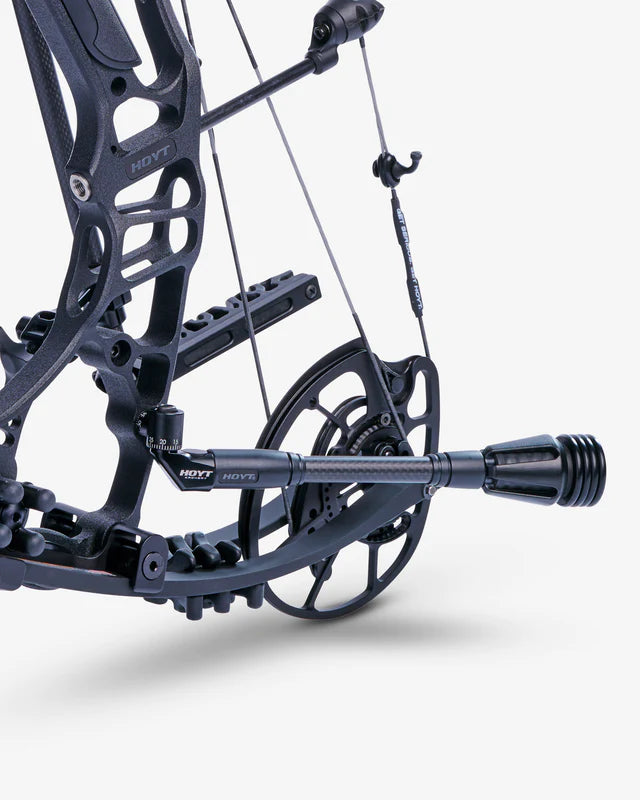Update Your Archery Game: Choosing the Perfect Compound Bow Stabilizer
Update Your Archery Game: Choosing the Perfect Compound Bow Stabilizer
Blog Article
Optimizing Your Archery Efficiency With the Right Substance Bow Stabilizer: a Comprehensive Summary
In the realm of precision, consistency and archery are vital to accomplishing ideal efficiency. One often-overlooked yet critical component in improving accuracy is the substance bow stabilizer. This unassuming gadget plays a substantial role in steadying your aim, lowering bow torque, and absorbing resonances. The efficiency of a stabilizer hinges on different factors, including design, weight, and positioning. By understanding the nuances of choose and maximizing a substance bow stabilizer, archers can tweak their tools to boost their shooting experience to brand-new degrees of effectiveness and control.
Importance of Bow Stabilizers in Archery

Additionally, bow stabilizers help in stabilizing the weight circulation of the bow, which can improve the archer's security while aiming and firing. By adding weight to the front of the bow, stabilizers can decrease the quantity of torque experienced upon launch, resulting in a smoother and much more controlled shot - compound bow stabilizer. This weight circulation likewise aids in holding the bow consistent for a longer period, allowing the archer to aim much more properly
Kinds Of Substance Bow Stabilizers
When considering the various kinds of substance bow stabilizers readily available, it is important to recognize their distinctive features and features to determine the most ideal alternative for making the most of archery efficiency. The most typical types of substance bow stabilizers consist of sidebar stabilizers, front stabilizers, and back stabilizers. Back stabilizers, also called rear stabilizers, are mounted to the back of the bow and assist in counteracting the weight of various other devices, resulting in enhanced stability and stable intending.
Aspects to Consider When Selecting
In reviewing substance bow stabilizers, comprehending the distinct attributes and features of each kind is vital for making a notified choice on one of the most appropriate option to enhance archery performance. When choosing a stabilizer, one find more need to think about the weight of the stabilizer itself. While a much heavier stabilizer can supply more stability by decreasing the bow's activity, it may also create fatigue during long shooting sessions. Equilibrium is an additional essential element to consider. The stabilizer's size and style significantly impact the bow's equilibrium, affecting the shooter's capability to hold stable goal. Additionally, the product of the stabilizer can affect its performance. Carbon fiber stabilizers are light-weight and soak up vibrations well, boosting accuracy. The number and adjustability of dampeners on the stabilizer can adjust its efficiency by minimizing sound and shock upon release. By very carefully evaluating these elements, archers can pick a substance bow stabilizer that aligns with their shooting design and optimizes their general performance on the archery variety.
Installment and Adjustment Tips
For optimal performance and precision in archery, mastering the installation and change of your bow stabilizer is important. Proper installation begins with connecting the stabilizer to the bow's riser, ensuring it is strongly secured. A lot of stabilizers feature mounting hardware for simple setup, however it's important to comply with the manufacturer's standards for the specific design you have. When affixed, changing the stabilizer involves locating the best equilibrium between weight circulation and length. Trying out various combinations up until you attain the wanted feeling and stability.
When changing the stabilizer, begin with small step-by-step adjustments instead than drastic modifications. Pay attention to exactly how the bow responds to changes in stabilizer setups and make adjustments as necessary. Regularly check the stabilizer's rigidity and total problem to ensure it continues to work efficiently.
Upkeep and Treatment Guidelines

It is likewise essential to save your bow with the stabilizer in a secure and safe place when not in use. Adhering to these upkeep and treatment guidelines will certainly assist you get the most out of your bow stabilizer and enhance your overall archery efficiency.
Conclusion
Finally, choosing the ideal substance bow stabilizer is crucial for taking full advantage of archery performance. Understanding the relevance, kinds, elements to think about, installation and modification ideas, as well as maintenance and care guidelines can considerably affect one's precision and uniformity in shooting. By picking a stabilizer that matches individual demands and choices, you can try these out archers can enhance their total performance and achieve better results on the range or in competition.
Bow stabilizers play an important function in enhancing an archer's accuracy and consistency by decreasing resonances and maintaining the bow throughout the release of an arrowhead - compound bow stabilizer.Furthermore, bow stabilizers help in stabilizing the weight distribution of the bow, which can boost the archer's stability while firing and intending. The most common types of compound bow stabilizers consist of sidebar stabilizers, front stabilizers, and back stabilizers. Back stabilizers, also called rear stabilizers, are installed to the back of the bow and help in counteracting the weight of various other devices, resulting in boosted stability and stable aiming. When selecting a stabilizer, one have to think about the weight index of the stabilizer itself
Report this page